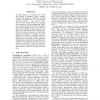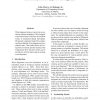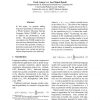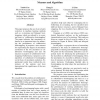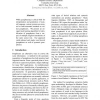ACL
2001
14 years 28 days ago
2001
For ambiguous sentences, traditional semantics construction produces large numbers of higher-order formulas, which must then be -reduced individually. Underspecified versions can ...
ACL
2003
14 years 28 days ago
2003
We introduce a MetaGrammar, which allows us to automatically generate, from a single and compact MetaGrammar hierarchy, parallel Lexical Functional Grammars (LFG) and Tree-Adjoini...
ACL
2001
14 years 28 days ago
2001
We aim at finding the minimal set of fragments which achieves maximal parse accuracy in Data Oriented Parsing. Experiments with the Penn Wall Street Journal treebank show that cou...
ACL
2003
14 years 28 days ago
2003
In this paper, we present a learning approach to the scenario template task of information extraction, where information filling one template could come from multiple sentences. ...
ACL
2001
14 years 28 days ago
2001
In this paper, we compare the relative effects of segment order, segmentation and segment contiguity on the retrieval performance of a translation memory system. We take a selecti...
ACL
2003
14 years 28 days ago
2003
Word alignment plays a crucial role in statistical machine translation. Word-aligned corpora have been found to be an excellent source of translation-related knowledge. We present...
ACL
2001
14 years 28 days ago
2001
In this paper, we propose adding long-term grammatical information in a Whole Sentence Maximun Entropy Language Model (WSME) in order to improve the performance of the model. The ...
ACL
2003
14 years 28 days ago
2003
This paper proposes the use of uncertainty reduction in machine learning methods such as co-training and bilingual bootstrapping, which are referred to, in a general term, as ‘c...
ACL
2001
14 years 28 days ago
2001
While paraphrasing is critical both for interpretation and generation of natural language, current systems use manual or semi-automatic methods to collect paraphrases. We present ...
ACL
2003
14 years 28 days ago
2003
Pipelined Natural Language Generation (NLG) systems have grown increasingly complex as architectural modules were added to support language functionalities such as referring expre...

